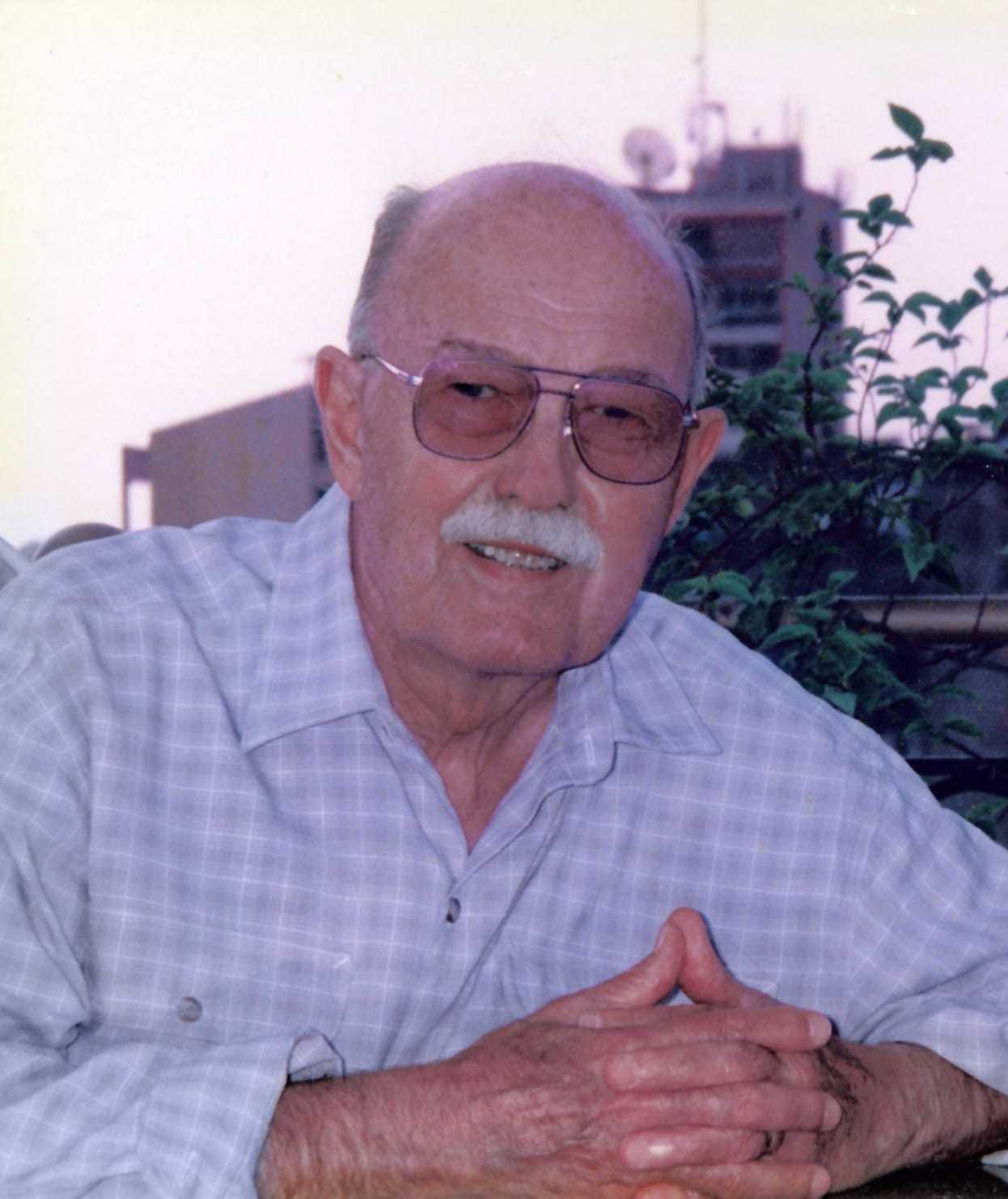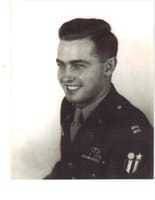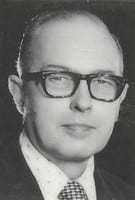Conrad “Connie” Edward LaGueux was one of the last Americans to leave Saigon—a moment that marked the end of the Vietnam War.
For LaGueux, who had led US intelligence missions in both World War II and Vietnam, the fall of Saigon was a difficult, complicated, and controversial chapter in American history. It took him another 25 years before he could bring himself to set foot in Saigon (now known as Ho Chi Minh City) again. But once there, he remarked how happy he was to see for himself that the people of Saigon were going to be okay.
Although the story of the fall of Saigon is familiar to many, the role of CIA officers, such as LaGueux, in those final days is not as well known.

LaGueux with famous Pittman Apartment evacuation point in background. Saigon (now Ho Chi Minh City), Vietnam. 2000.
LaGueux joined the CIA in 1949, two years following its creation. Previously, at the age of 22, he served as commander of a 15-man OSS Operation Group (OG) during WWII that parachuted behind enemy lines in France.
Working alongside French resistance fighters, LaGueux’s team derailed a German troop train, which resulted in the subsequent surrender of over 5,800 Nazi soldiers — an event central to the liberation of southern France known as the TARN.
He and some of his OG team members were then deployed to the China-Burma-India theatre to help train Chinese Nationalist Paratroops to assist Chiang Kai-shek’s army to fight the Japanese.
LaGueux’s work during WWII earned him a Bronze Star.

When LaGueux joined the CIA, his native French language earned him a position in the European Division of the Directorate of Plans (now the Directorate of Operations). However, an old OSS colleague soon convinced him to change his career direction and accept a lengthy posting with the Far East Division (now East Asia Division).
Over the years, LaGueux would assume many senior leadership positions in the division, both at Headquarters and overseas. He quickly earned a reputation for having a keen analytical mind and the ability to overcome numerous complex operational and administrative problems.
A key moment in LaGueux’s long tenure with the Agency came when he was serving as Deputy Chief of the CIA office in Saigon, then the largest overseas station in the world.

The Fall of Saigon
Under the January 1973 Paris Peace Accords, the United States agreed to withdraw its military forces from South Vietnam, while the North Vietnamese conceded that they, in turn, would restrict their support to communist forces in South Vietnam who were attempting to remove the US-backed government.
The ceasefire did not endure, and after sporadic conflict, the North Vietnamese launched a major offensive into South Vietnam in February 1975 when the North Vietnamese Army (NVA) first attacked Ban Me Thuot.
This was a decisive battle of the Vietnam War, which led to the complete destruction of South Vietnam’s II Corps Tactical Zone. The battle was part of a larger North Vietnamese military operation known as Campaign 275 to capture the Tay Nguyen region, known in the West as the Vietnamese Central Highlands.
Receiving intelligence about the NVA offensive and the results of a poorly planned and executed South Vietnamese Army (ARVN) evacuation of the Central Highlands, LaGueux hopped a ride aboard an Air America helicopter—a CIA proprietary airline during the Vietnam War—to see the situation for himself.
Buses, jeeps, cars, and military trucks jammed the road leading to the central coast region of South Vietnam, known as Route 7, carrying thousands who had fled the country’s northern and western provinces.
LaGueux’s colleagues recalled that it was in that moment that LaGueux knew the war was over. His experience with the OSS during WWII taught him that there was nothing more difficult than organizing and executing a successful retreat.
With the mass exodus of civilian and South Vietnamese military personnel now fleeing the onslaught by the North Vietnamese forces, it would be next to impossible for the South Vietnamese to mount an effective defense.
The Evacuation
LaGueux returned from his reconnaissance mission with crucial evidence of the seriously deteriorating situation. The North Vietnamese had overrun the South Vietnamese forces with relative ease and were moving south toward Saigon.
In Saigon, US Ambassador Graham Martin hesitated calling for an evacuation of US personnel, although he did reduce the size of the US mission. Martin likely hoped that a smaller South Vietnamese republic, encompassing the city and surrounding area, could endure. Even if that proved impossible, he wanted to avoid spurring chaos among the Saigon populace by abruptly evacuating the US Embassy.
LaGueux and his boss, the Chief of the CIA office in Saigon, Thomas Polgar (also a former OSS officer), reduced the CIA staff as well, and urged Martin and CIA leadership to press the South Vietnamese to seek another ceasefire. By mid-April, however, intelligence made clear the North Vietnamese had no interest in negotiation.
On April 27, North Vietnamese forces surrounded Saigon and shelled the critical Tan Son Nhut Air Base, which made any further departures by airplane impossible.
This marked the start of Operation FREQUENT WIND, which used helicopters from the Marines and Air America to ferry out US personnel (and as many South Vietnamese as possible) to US Navy ships of the 7th Fleet off the coast.
LaGueux planned and implemented the evacuations of all Americans in the country.
This huge undertaking included planning and executing the successful evacuation of all US diplomatic staff with families; all US military personnel with families; many US and allied European businessmen and reporters with families; plus as many Agency assets and families as they could get out.
On top of all of this, LaGueux was tasked with evacuating as many of the senior South Vietnamese government officials, military staff, and their families as he could.
Just before 11:00 AM on April 29, a complete evacuation was ordered.
Americans in Saigon had already received evacuation orders and were told to keep a close-hold on the information to prevent a city-wide panic.
When the American Radio Service announced that the temperature in Saigon was “105 degrees and rising” and then played the Bing Crosby song “White Christmas,” personnel knew they had to immediately go to their nearest assembly point (there were 14 around the city).
The central departure point was the US Embassy itself, where helicopters could land on the roof of the building and a small parking lot.

Evacuees helped aboard Air America helicopter perched atop Pittman Apartments on April 29, 1975.
One of the most famous photographs during the fall of Saigon—the one of the helicopter precariously perched atop a building (as seen above), with the pilot leaning out to help a long line of refugees scrambling up a steep ladder—captures what many believe is the evacuation of the US Embassy on April 29.
What most people don’t know is that it was actually LaGueux’s apartment complex — the Pittman Apartments, one of several designated pick-up spots around Saigon — where that iconic photograph was taken, and not the US Embassy, which was located a few blocks away.
On the morning of April 30, 1975, LaGueux, Polgar, and the Ambassador were among just a handful of Americans left in the Embassy as the North Vietnamese arrived at the outskirts of the city. In the early morning hours, Polgar cabled to CIA Headquarters, “…this will be the final message from Saigon … It has been a long and hard fight and we have lost.”
About 4:00 AM, a helicopter landed at the US Embassy. A Marine climbed out and approached the Ambassador. He said, “Sir, President Ford has given me orders to carry you aboard this helicopter if you don’t go voluntarily. It’s time to leave.”
That meant it was finally time for LaGueux to leave as well, although he had continued working right up until the bitter end. He and Polgar destroyed their secure communications equipment and climbed aboard the waiting chopper with the Ambassador and were delivered to the USS Blue Ridge.
Saigon would fall before the day was through.
The total evacuations during April, including those conducted during the two-day Operation FREQUENT WIND, resulted in around 6,000 Americans being flown out and ensured that all US personnel who wanted to leave Vietnam had the opportunity to do so.
Additionally, around 65,000 South Vietnamese, including many of the local hires for the State Department and CIA, were flown out as well.
My family is your husband’s ‘Schindler’s list’
Years after the fall of Saigon, Connie LaGueux and his wife were invited to dinner at the home of a Vietnamese doctor and his family whom LaGueux had helped to evacuate to America.
The doctor wanted to thank LaGueux, and to show him how well his family was doing. His children had grown into successful, happy adults, including one who also became a doctor like her father.
While eating dinner together, one of the doctor’s daughters turned to LaGueux’s wife and said, “I want you to look around, Mrs. LaGueux, and I want you to look at my family in this room. My family is your husband’s ‘Schindler’s list.’ We would have been dead if it had not been for your husband.”
Connie LaGueux retired from the CIA in 1977, and on July 31, 2001, he was buried in Arlington National Cemetery with full military honors.

